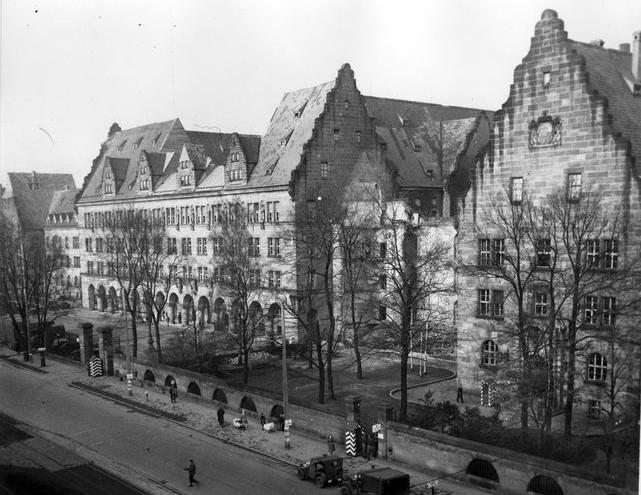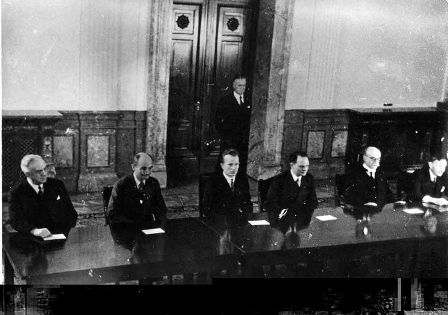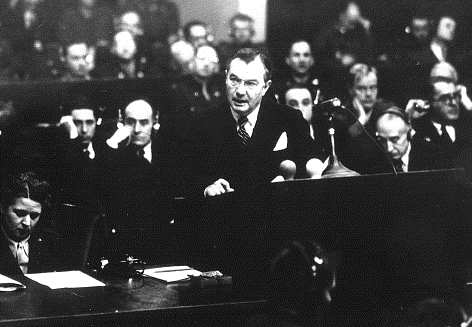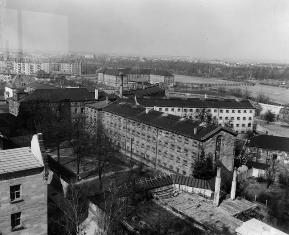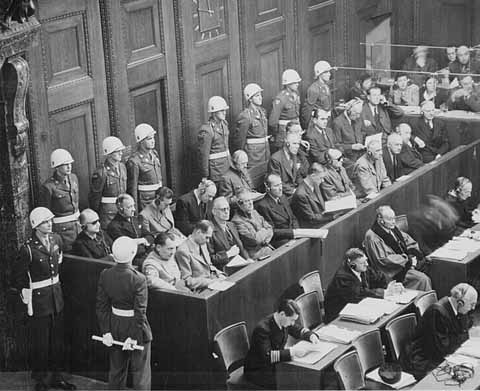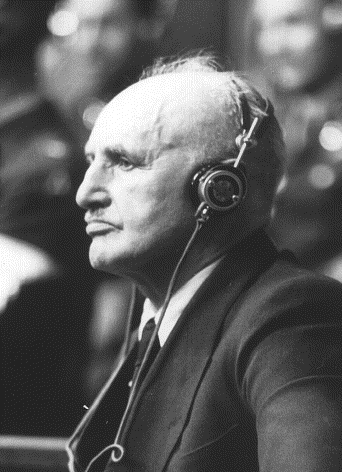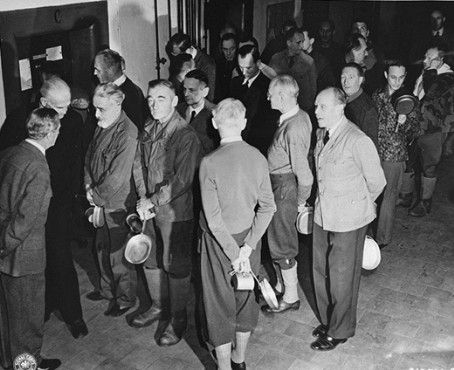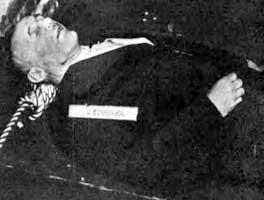|
Holocaust Education & Archive Research Team |
|
Trials Introduction to the Holocaust Trials
Trials
Interrogations & Testimonies
The IMT Series Nazi Justice | ||||||||
The 1st Nuremberg Trial Nurnberg International Military Tribunal
Prelude to Nürnberg
Papers released on January 2, 2006 from the British War Cabinet in London have shown that as early as December 1942, the Cabinet had discussed their policy for the punishment of the leading Nazis if captured. British Prime Minister Winston Churchill had then advocated a policy of summary execution with the use of an Act of Attainder to circumvent legal obstacles, and was only dissuaded from this by pressure from the U.S. later in the war.
In April, 1945, two weeks after the sudden death of President Roosevelt, Supreme Court Justice Robert Jackson received Samuel Rosenman at his Washington home. Rosenman asked Jackson, on behalf of President Truman, to become the chief prosecutor for the United States at a war-crimes trial to be held in Europe soon after the war ended.
Truman wanted a respected figure, a man of unquestioned integrity, and a first-rate public speaker, to represent the United States. Justice Jackson, Rosenman said, was that person. Three days later, Jackson accepted. On May 2, Harry Truman formally appointed him chief prosecutor. But prosecutor of whom, and under what authority? Many questions remained unanswered. Still, many important Axis leaders had fell into Allied hands, either through surrender or capture. Deputy Fuhrer Rudolph Hess had been held in England since 1941, when he had parachuted into the English sky in a solo effort to convince British leaders to make peace with the Nazi government. Reischsmarschall Hermann Goering surrendered to Americans on May 6, 1945.
He spent his first evening in captivity happily drinking and singing with American officers--officers who later were reprimanded by General Eisenhower for the special treatment they conferred. Hans Frank, "the Jew Butcher of Cracow," received less hospitable treatment from American soldiers in Bavaria, who forced him to run through a seventy-foot line of soldiers, getting kicked and punched the whole way.
Other suspected war criminals were rounded up on May 23 by British forces in Flensburg, site of the last Nazi government. The Flensburg group included Karl Doenitz (Hitler's successor as Fuhrer), Field Marshall Wilhelm Keitel, Nazi Party philosopher Alfred Rosenberg, General Alfred Jodl, and Armaments Minister Albert Speer. Eventually, twenty-two of these captured major Nazi figures would be indicted.
On June 26, Robert Jackson flew to London to meet with delegates from the other three Allied powers for a discussion of what to do with the captured Nazi leaders. Every nation had its own criminal statutes and its own views as to how the trials should proceed. Jackson devoting considerable time to explaining why the criminal statutes relating to wars of aggression and crimes against humanity that he proposed drafting would not be ex post facto laws.
Jackson told negotiators from the other nations, "What we propose is to punish acts which have been regarded as criminal since the time of Cain and have been so written in every civilized code."
The delegates also debated whether to proceed using the Anglo-American adversarial system with defense lawyers for the defendants, or whether instead to use the judge-centered inquisitive system favored by the French and Soviets.
The indictments against the defendants would prohibit defenses based on superior orders, as well as tu quoque (the "so-did-you" defense). Delegates were determined not to let the defendants and their German lawyers turn the trial into one that would expose questionable war conduct by Allied forces.
Location
The Soviet Union had wanted the trials to take place in Berlin, but Nürnberg was chosen as the site for the trials for specific reasons:
The city was 91% destroyed, but in addition to the Palace of Justice, the best hotel in town--the Grand Hotel--was miraculously spared and would serve as an operating base for court officers and the world press. Over the objection of the Soviets (who preferred Berlin), Allied representatives decided to conduct the trial in Nürnberg. On August 6, the representatives signed the Charter of the International Military Tribunal, establishing the laws and procedures that would govern the Nürnberg trials. Six days later, a cargo plane carrying most of major war trial defendants landed in Nürnberg. Allied military personnel loaded the prisoners into ambulances and took them to a secure cell block of the Palace of Justice, where they spent the next fourteen months. Judges for the IMT met for the first time on October 13. The American judge was Francis Biddle, who was appointed to the job by Harry Truman--perhaps out of a feeling of guilt after the President dismissed him as Attorney General. Robert Jackson pressured Biddle, who desperately wanted the position of chief judge, to support instead the British judge, Sir Geoffrey Lawrence. Jackson thought the selection of a British as president of the IMT would ease criticism that the Americans were playing too large a role in the trials. Votes from the Americans, British, and French elected Lawrence chief judge.
With a November 20 opening trial date approaching, Nürnberg began to fill with visitors. A prosecutorial staff of over 600 Americans plus additional hundreds from the other three powers assembled and began interviewing potential witnesses and identifying documents from among the 100,000 captured for the prosecution case. German lawyers, some of whom were themselves Nazis, arrived to interview their clients and began trial preparation. Members of the world press moved into the Grand Hotel and whatever other quarters they could find and began writing background features on the upcoming trial. Nearly a thousand workers rushed to complete restoration of the Palace of Justice. The Indictment
The United States of America, The French Republic, The United Kingdom of Great Britain and Northern Ireland, and the Union of Soviet Socialist Republics against:
Hermann Wilhelm Goering, Rudolf Hess, Joachim von Ribbentrop, Robert Ley, Wilhelm Keitel, Ernst Kaltenbrunner, Alfred Rosenberg, Hans Frank, Wilhelm Frick, Julius Streicher, Walter Funk, Hjalmar Schact, Gustav Krupp von Bolhlem und Halback, Karl Doenitz, Erich Raeder, Baldur von Shirach, Fritz Sauckel, Alfred Jodl, Martin Bormann, Franz von Papen, Arthur Seyss-Inquart, Albert Speer, Constantin von Neurath, and Hans Fritzsche, individually and as Members of Any of the Following Groups or Organizations to which They Respectively Belonged, Namely:
NS Fritzsche, Die Reichs Regierung (Reich cabinet); Das Korps der Politischen Leiter der National Sozialisticshen Deutschen Artbeiterpartei ( Leadershp Corps of the Nazi Party); Die Schutzstaffen Der National Sozialisticshen Deutschen Artbeiterpartei (commonly known as the "SS") and including Der Sicherheitsdienst (commonly known as the "SD") Die Geheime Staatspolizei (Secret State Police, commonly known as the "Gestapo"); Die Sturm Abeteilungen der NSDAP (commonly known as the "SA"); and the General Staff and High Command of the German Armed Forces.
The Tribunal established by the Agreement referred to in Article 1 hereof for the trial and punishment of the major war criminals of the European Axis countries shall have the power to try and punish persons who, acting in the interests of the European Axis countries, whether as individuals or as members of organizations, committed any of the following crimes. The following acts, or any of them, are crimes coming within the jurisdiction of the Tribunal for which there shall be individual responsibility:
Leaders, organizers, instigators, and accomplices participating in the formulation or execution of a Common Plan or Conspiracy to commit any of the foregoing crimes are responsible for all acts performed by any persons in execution of such plan.
The Defendants
The Trial The trial began on November 20, 1945, and concluded on October 1, 1946. Thirty-three witnesses testified for the prosecution. Eighty witnesses testified for the defense, including nineteen of the defendants. An additional 140 witnesses provided evidence for the defense through written interrogatories. The prosecution introduced written evidence of its own, including original military, diplomatic, and government files of the Nazi regime that fell into the hands of the Allies after the collapse of the Third Reich. Jackson commenced the trial with an opening statement that is considered one of the most eloquent in the annals of jurisprudence. "The wrongs which we seek to condemn and punish," Jackson said, "have been so calculated, so malignant, and so devastating that civilization cannot tolerate their being ignored because it cannot survive their being repeated… . That four great nations, flushed with victory and stung with injury, stay the hand of vengeance and voluntarily submit their captive enemies to judgment of the law is one of the most significant tributes that power has ever paid to reason." The prosecution case was divided into two main phases. The first phase focused on establishing the criminality of various components of the Nazi regime, while the second sought to establish the guilt of individual defendants. The first prosecutorial phase was divided into parts.
A second part of the prosecution case concerned the Nazi's use of slave labor and concentration camps. Evidence introduced during this part of the prosecution case brought home the true horror of the Nazi regime. For example, on December 13, 1945, U. S. prosecutor Thomas Todd introduced USA Exhibit #253: tanned human tattooed skin from concentration camp victims, preserved for Isle Koch, the wife of the Commandant of Buchenwald, who liked to have the flesh fashioned into lampshades and other household objects for her home. Then Todd introduced USA Exhibit #254: the fist-shaped shrunken head of an executed Pole, used by Koch as a paperweight.
The affidavit described an experiment conducted to determine what method to use to save German fliers pulled out of freezing North Sea waters. Rascher ordered inmates stripped naked and then thrown into tanks of freezing water. Chunks of ice were added, as workers repeatedly thrust thermometers into the rectums of unconscious inmates to see if they were sufficiently chilled. Then the inmates were pulled out of the tanks to see which of four methods of warming might work best. Most inmates were dropped into either tanks of hot water, warm water, or tepid water. One quarter of the inmates were placed next to the bodies of naked female inmates. (Rapid warming with hot water was determined to be most effective.) Rascher stated in his affidavit that most of the inmates used in the experiment went into convulsions and died. In January, a series of concentration camp victims testified about their experiences. Marie Claude Vallant-Couturier, a 33-year-old French woman, provided particularly powerful testimony about what she saw at Auschwitz in 1942.
Vallant-Couturier described how a Nazi orchestra played happy tunes as soldiers separated those destined for slave labor from those that would be gassed. She told of a night she was "awakened by horrible cries. The next day we learned that the Nazis had run out of gas and the children had been hurled into the furnaces alive."
Siegfried Ramler was an interpreter at the Nuremberg war crimes trials. Here is his impression of Hermann Goering:
If one can speak of a dominant personality in the dock, Hermann Goering definitely fits that description as the leading defendant. Prison diet and discipline seem to have improved his health, since he was forced to wean himself from a drug dependency. He lost weight and he was mentally alert, as demonstrated by his ability to spar effectively with Chief Prosecutor Robert Jackson during his cross examination.
From the very beginning of the trial he took it on himself to direct the strategy of his codefendants by sending notes from the dock to various defense lawyers with suggestions of issues to be raised, questions to be asked, and witnesses to be called. This manipulative behavior became an irritant to the court and he was ordered to limit his communications to his own defense counsel and to issues pertaining to his own defense. During a period of time during the trial one of my duties was to check his notes to counsel before they were passed on and to ascertain that they were related to his own defense. Goering wanted the German leaders in the dock to present a united front, an aim in which he could not succeed. The disparity among the defendants in their backgrounds and in their roles in relation to Hitler was too great.
For example, such individuals as the banker Hjalmar Schacht or the diplomat Constantin Von Neurath would not even deign to speak to such defendants as Gauleiter Julius Streicher or SS Chief Ernst Kaltenbrunner. Goering's personal vanity was evident throughout the trial. When testimony was presented about his penchant for luxury or his looting of art works from occupied countries, he became visibly angry - more so than when the larger issues of his involvement with aggressive war and war crimes were the subject during his examination on the stand. He escaped hanging by swallowing a concealed cyanide pill in his cell shortly before the scheduled execution.
It is likely that the pill was passed to him by an American officer of the guard detail whom he had befriended. I recall him sitting in the first seat in the front row of the dock, often with a supercilious smile, perhaps knowing that he would cheat the hangman."
The prosecution rested on March 6. After the thirty-three witnesses and hundreds of exhibits that had been produced, no one could deny that crimes against humanity had been committed in Europe.
The Verdicts
Legacy of the Trials The Nürnberg trials made three important contributions to international law. First, they established a precedent that all persons, regardless of their station or occupation in life, can be held individually accountable for their behavior during times of war. Defendants cannot insulate themselves from personal responsibility by blaming the country, government, or military branch for which they committed the particular war crime. Sources: The Truman Library The Holocaust Chronicle Publications International LTD The Nürnberg Trial Ana & John Tusa Mcgraw-Hill; Reprint edition (September 1985) Harvard Law School "Nürnberg Trials Project" http://Nürnberg.law.harvard.edu/php/docs_swi.php?DI=1&text=overview Trial of the Major War Criminals Before the International Military Tribunal, Nürnberg, 14 November 1945-1 October 1946. Buffalo: William S. Hein, 1995. (JX 5437.3 .I58 1995)
Copyright. Carmelo Lisciotto H.E.A.R.T 2007
|
